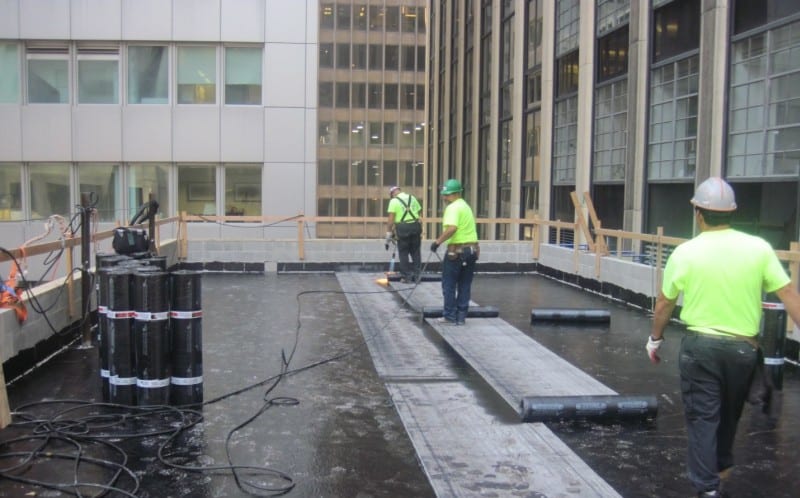There are plenty of roofing materials out there, which can make choosing one quite difficult. Most of the homeowners either prefer to have asphalt shingles or wood shakes because they are found on every house.

This doesn’t mean that you toe the same line. Yes, these options and others work fine if you have a slope roof but what about a flat roof?
The options here might be limited but they offer great benefits. Let’s start with one that is quickly becoming quite popular: built-up roofing.
What is Built-Up Roofing?
Built-up roofing, also known as BUR is roofing material for low-slope roofs. This roofing system contains alternating layers of bitumen (asphalt), tar, coal tar and reinforcing fabric, and is then finished with an aggregate layer like gravel or stone.
The reason why this roofing material is now being preferred over others for low-slope roof is because it delivers a continuous sealed surface.
Here is a great video showing the history, features and benefits of this type of roof.
Types of BUR
There are 3 types of Built-Up-Roofing, which include:
- Ballasted asphalt built-up
- Cold built-up
- Hot built-up
Let’s discuss each type briefly:
Ballasted Asphalt Built-Up
A ballasted roof is not adhered or anchored to the roof membrane in any way. When it was first introduced, people were confused about its durability. Since lose gravel is spread over the deck, they were worried that a strong gust of wind would expose the deck.
The gravel and the stones used in this roofing type have a bigger diameter. A thick layer is applied with fasteners and plates here and there, there’s no excess movement.
The installation is pretty easy because the gravel is simply blasted on the deck. In fact, this roofing system can be installed any time, under any weather condition. Moreover, the stones are virtually fireproof, which puts BUR right at the top on the list of fire-resistant roofing systems.
Cold Built-Up
A cold built-up roof is applied using a squeegee. There are no toxic fumes involved in the installation and any change in the weather does not affect its application.
Hot Built-Up
A hot built-up roof uses liquefied bitumen. Its installation is the most difficult compared to a cold built-up roof and ballasted asphalt built-up roof.
Pros and Cons of a Built-Up Roof
Pros
- Provides great ultra-violet protection
- Is waterproof
- Lasts longer even in areas where the weather is constantly changing
- Life expectancy: 15 to 30 years
Cons
- Slower to install (especially a hot built-up roof)
- Installation cost is pretty high
- The hot built-up roof installation releases hazardous vapors and fumes
- Vulnerable to wind and water damage
Material
Built-up roofing contains three materials: bitumen, ply sheets and a surface material such as asphalt or gravel.
Here’s a layer by layer explanation:
It consists of an impervious membrane assembled from layers of bituminous saturated felt, which are cemented to each other and to the roof deck with bituminous cement, usually asphalt or coal-tar pitch.
Built-up roofs may be either surfaced or un-surfaced. The bitumen used in the former roof is always asphalt, while both coal-tar and asphalt are used in the latter. Built-up roofs subject to too much foot traffic is finished with promenade tile embedded in a coating of cement mortar, which is then laid over the final mopping of bitumen.
Cost of BUR
According to 2019 roofing estimates, the installation cost of a built-up roof is as follows:
- Material Cost (Per Square Foot): $5 to $8
- Installation Cost: $1,113
- Labor Cost: $3,879
- Job Supplies: $150
- Equipment Cost: $86
- Total Cost: $5,228
*If you use high quality material, the cost of the overall installation will rise.
Comparison with Single-Ply Membrane Roofing
Single-ply roofing contains sheet of rubbers, as well as other synthetic materials that are blasted or chemically adhered to the roof’s insulation. There are two types of single-ply roofing materials: Ethylene Propylene Diene Terpolymer (EPDM) and Thermoplastic Polyolefin (TPO).
The cost of single-ply roofing is lesser than built-up roofing, which is outlined below:
- EPDM: $3.50 to $7.50/sq ft
- TPO: $3.50 to $6.50/sq ft
There are a couple of reasons why one roof type is considered over the other. Both are highly resistant to fire. However, single-ply roof has a class “A” fire rating. Moreover, it is retentive and reflective. Lastly, customers can choose any type of insulation material, which is not an option given in built-up roofing.
Here are the reasons we think built-up roofing is a better option than single-ply roofing:
- Since a single-ply roof does not have a hard layer, sharp objects pushed into the rubber layer can cause leaks
- The seams are sealed with melting adhesives, which makes the roof vulnerable to leaks
- With vents and skylights on the roof, installation becomes tricky
- Direct UV rays falling on the roof can lower its durability
So, which roofing option are you going to choose? If you are looking for more roofing related articles like this, then visit our architecture and exterior design articles.
Related Posts
- What Type of Plywood is used for Roofing? Size and Thickness Guide
- Advantages and Disadvantages of Solar Roof Vents for Homes
- 10 Different Types of Snow Guards for Metal Roofs
- Advantages and Disadvantages of Roof Ridge Vents for Homes
- 5 Unique Roof Upgrades to Consider for Your Home
- Pros and Cons of TPO Roofing – Cost, Advantages, Disadvantages
Wow, it’s great to know that built-up roofing systems can help a lot in protecting my home from ultraviolet rays. I recently moved to a slightly southern state and the summer here is quite harsh when it comes to the amount of sunlight. I think will have to get the necessary home improvements in order to adapt to this kind of climate.